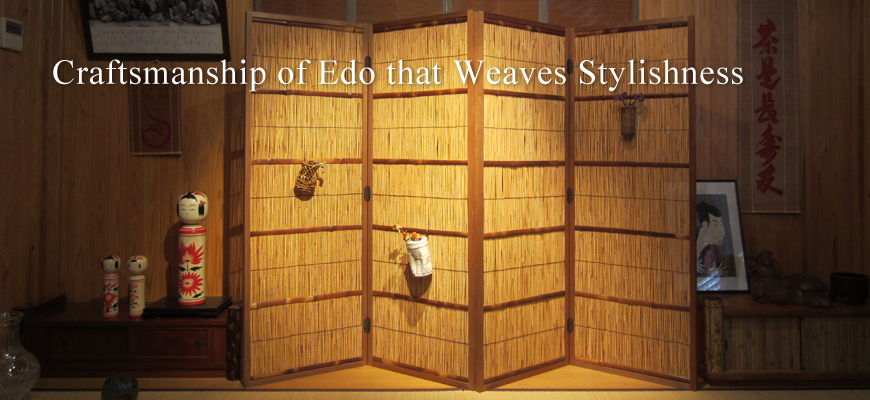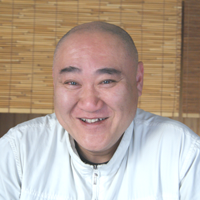
Kotaro Tanaka
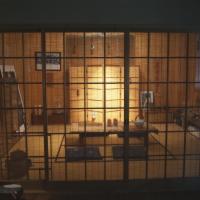
The second floor of his studio is a showroom of bamboo blinds.
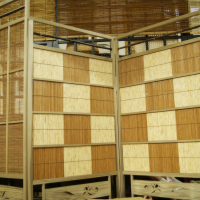
Bamboo blinds have been used as partitions or sunshades from ancient times.
What are Edo-style bamboo blinds?
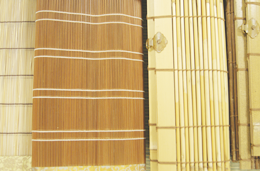
Bamboo blinds from which patterns are cut out
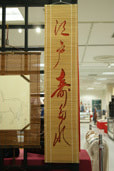
I put marks on patters, which will be cut out from a normally-woven bamboo blind, and cut out the marked patterns with a knife after undoing the bamboo blind. Then, I weave the bamboo blind again in the same order so that the patterns, such as pictures and characters, can be seen. The patterns are stronger than ones depicted on paper, and are not broken by moderate wind and rain. Once I fixed a bamboo blind with a family crest cut out from it, which is attached to a palanquin, so I think bamboo blinds with characters or family crests cut out from them have been used from old times.
As an Edo-style bamboo blind craftsman
Could you tell me about the reason you chose to be a craftsman?
I had no special reason. I had no intention to be a craftsman. I did not want to be a craftsman rather than having no intention. A craftsman makes something all day without rest, so it seems very hard. I remained at a laboratory and kept studying after graduating from university. However, later, I became a craftsman. Well, I used tools and helped my father's job since my childhood. I have worked as a full-time craftsman for about 25 years.
Could you tell me about the history of Tanaka Seirenjo?
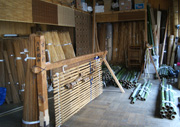
Studio
Edo-style bamboo blinds
How have bamboo blinds developed?
People who wove bamboo gathered in places where bamboo, that is, material for bamboo blinds, could be obtained. In such places, people split bamboo and made bamboo blinds. Bamboo blinds were also made in consuming regions. For example, although it is no longer the case, Osaka, Nagoya and Kyoto were famous as places where bamboo blinds were consumed. Bamboo blind craftsmen also exited in those places, and laid in a stock of bamboo from neighboring areas. Tokyo is not a place where a lot of bamboo can be obtained, so craftsmen in Tokyo get bamboo from suburbs. I think craftsmen also did so in the Edo Period.
In the case of Edo-style bamboo blinds, have they developed in a consuming region?
Yes. In the past, materials were brought in Edo from many regions according to demands. Taking advantage of moats and rivers, distribution systems were built. Materials were carried by boat. Therefore, many craftsmen lived near those water channels, such as Kanda. The same can be said for not only bamboo blind craftsmen but also other craftsmen. There were riverfronts around Iidabashi, from which materials, such as wood, were landed and transported. Also, there were many craftsmen in Ichigaya. Since there was a riverfront dedicated to bamboo in Kyobashi, so it was called "Take-gashi," or bamboo riverfront. The Sumida River became a distribution center, so Taito City has had the largest number of craftsmen.
An antique map of Edo: Owned by the National Diet Library
What types of bamboo blinds are there?
Basically, I make anything that customers want. Bamboo blinds fall into 4 general categories. "Sotogake Sudare" is hung outside of a house for keeping off the sun or as a screen. "Uchigake Sudare" is used in Japanese-style rooms, shrines and temples. Nowadays, it is sometimes hung on windows. There are also small bamboo mats, which are used for making a sushi roll or used as "Banju," or mat on which Japanese-style confections are put. I have also recently made table covers and coasters out of bamboo. Finally, there are applied bamboo blinds, including ones that are put on folding screens or sliding paper doors. Some customers ask me to make bamboo blinds that can be put on their crafts. Those special bamboo blinds are sometimes ordered.
What kind of materials do you use?
Besides bamboo, reed, cudweed, cattail and bush clover are used. I use different materials for different purposes according to characteristics of the materials. For example, I split bamboo, and make thin bamboo sticks. The bamboo sticks can be shaved to straighten the shapes. In the case of a bamboo mat, it is better to make the outer side of the mat flat, and the inner side semicylindrical or triangular if making serrated surfaces on food such as steamed fish paste. Other materials are used as they are, that is to say, in their natural forms, so they are not processed like bamboo. Bush clover can be tinted and polished, but it is curved because it is thin. When it is straightened with fire, its texture gets better. Since it is straightened with fire, it cannot be exposed to rain.
On the other hand, cudweed and reed withstand exposure to rain, so they can be placed outside of a house. Cattail is naturally whitish and easy to turn black, so taking advantage of that characteristic, they are used in places such as a tea room that has an atmosphere of elegant simplicity.

Although we, in some cases, recommend bamboo blinds, of which material characteristics suit particular places, for customers, if customers express their preferences, we introduce materials to customers, and use proper materials. Bamboo blinds do not play the leading role in a house. Bamboo blinds that keep off the sun are needed only if there is a house. Therefore, it is necessary to make blinds that fit colors of a house, wall and customer's preference.
Manufacturing processes
The manufacturing processes of bamboo blinds vary according to their shapes?
There are two types of manufacturing processes. When I make bamboo blinds, I cut bamboo to proper length, split it after washing and drying, and process bamboo sticks according to uses. In the case of other materials, there are a variety of processes and finishes according to materials. Since sticks made of materials other than bamboo have a variety of colors and characteristics, I should carefully sort out the sticks. Although I dispose of unusable sticks, sticks with wormholes and stains are still left in the final process. Thickness of sticks is also uneven, so I should sort out them according to their thickness and colors. After the materials are prepared, I can weave the sticks in accordance with orders.
Could you tell me about tools?
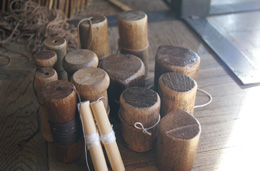
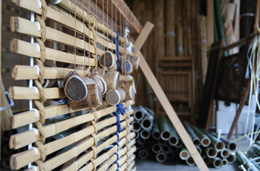
Utilizing techniques to make new products
Are there some special orders from customers?
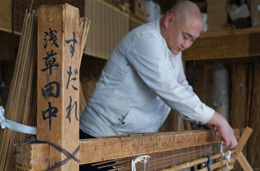

Kotaro Tanaka

The second floor of his studio is a showroom of bamboo blinds.

Bamboo blinds have been used as partitions or sunshades from ancient times.
What are Edo-style bamboo blinds?

Bamboo blinds were themes of some tanka poems in "Manyo-shu," the oldest anthology of tanka poems, and have been used as furnishing goods in the Court, shrines and temples. In the Edo Period, as many people came to Edo from provinces, bamboo blinds were widespread among commoners, and a variety of Edo-style bamboo blinds were produced out of necessity.
Bamboo blinds from which patterns are cut out

I put marks on patters, which will be cut out from a normally-woven bamboo blind, and cut out the marked patterns with a knife after undoing the bamboo blind. Then, I weave the bamboo blind again in the same order so that the patterns, such as pictures and characters, can be seen. The patterns are stronger than ones depicted on paper, and are not broken by moderate wind and rain. Once I fixed a bamboo blind with a family crest cut out from it, which is attached to a palanquin, so I think bamboo blinds with characters or family crests cut out from them have been used from old times.






